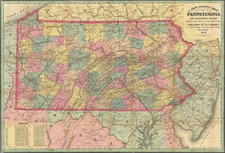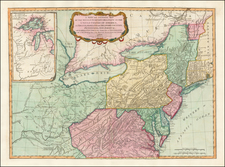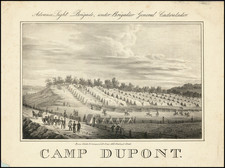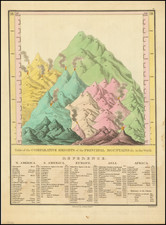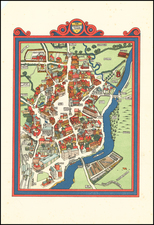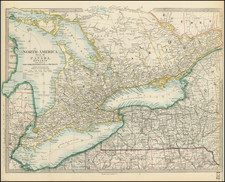An Early Architectural Drawing by One of America's Most Distinguished Early Architects
John Haviland signed and dated original pen and wash drawing for the ceiling of St. Andrews Episcopal Church in Philadelphia, built in 1821. The main ceiling design drawing is accompanied by an additional unsigned sheet with two drawings, one that appears to be a detail for the decorative plasterwork incorporated in the ceiling design, and a second that is a Greek Revival design for a wall, perhaps the same church. This additional drawing of plasterwork may be the work of Edward Evans, a prolific early Philadelphia plasterer, as these two drawings came from a larger unrelated group of materials by or concerning Evans. The latter occasionally did customized plaster ornaments for Haviland and other Philadelphia builders and architects. See Mark Reinberger's article, "A Plasterer's Daybook attributed to Edward Evans" for Evans's connection to Haviland.
Haviland and St. Andrew's Episcopal Church, 1822-23
The present drawing was made for one of Haviland's earliest works, St. Andrew's Episcopal Church, 256 S. 8th St., Philadelphia (1822–23). The church building is now the Greek Orthodox Cathedral of St. George. The handsome design reflects the taste of the day, and consists of a series of recessed squares arranged in a large rectangle, surrounding an elongated rectangular design in the center of the ceiling. The design incorporates a repeated decorative plaster motif which is detailed on the separate sheet accompanying the main design drawing.
The verso of the ceiling drawing sheet is signed by Haviland, William Thackara (named in One Hundred Notable American Engravers-1683-1850) and Cornelius Stevenson as members of the Building Committee. The design on the drawing is indicated as adopted on November 1st, 1822.
John Haviland (1792-1852) was born in England, but came to the United States as a young man, settling in Philadelphia in 1816. He worked on a number of landmark buildings in Philadelphia including the Walnut Street Theatre, Presbyterian Church at Norfolk, the State House, New Pennsylvania Hospital, Lancaster County Prison, and the "New Athenaeum" in Philadelphia. As part of his architectural work he published several books, most notably The Builder's Assistant (Philadelphia, 1818-1821), which included sample designs of both Greek and Roman architecture as well as directions for plasterers, among much other detailed practical information for builders.
Rarity
Early American architectural drawings by noted architects are rare in the market. There is an archival collection of material relating to John Haviland's architectural career held at the University of Pennsylvania. Notable, the 23 volumes that comprise that collection lack full renderings of architectural drawings.
John Haviland was American architect who was a major figure in American Neo-Classical architecture, and one of the most notable architects working from Philadelphia in the 19th century.
In 1811, Haviland was apprenticed to an architect in London. In 1815, Haviland tried unsuccessfully to obtain an appointment to the Russian Imperial Corps of Engineers. While in Russia, he met George von Sonntag and John Quincy Adams, who encouraged him to work in the United States.
Haviland moved to Philadelphia in 1816, one of the few formally trained professional architects working in the city at the time. Between 1818 and 1821, Haviland published The Builder's Assistant, one of the earliest architectural pattern books written and published in North America.
Haviland began to secure what would be his most important commissions in Philadelphia, including the Eastern State Penitentiary, the Pennsylvania Institution for the Deaf and Dumb (now Dorrance Hamilton Hall, University of the Arts), and the original Franklin Institute building (now home to the Atwater Kent Museum).
During this time, Haviland unwisely speculated in his own projects, including commercial arcades in Philadelphia and New York, as well as an amusement park. He was eventually forced into bankruptcy, tarnishing his professional reputation in Philadelphia.
Haviland was an Honorary and Corresponding Member of the Royal Institute of British Architects. In 1827, he was elected into the National Academy of Design as an Honorary Academician.











